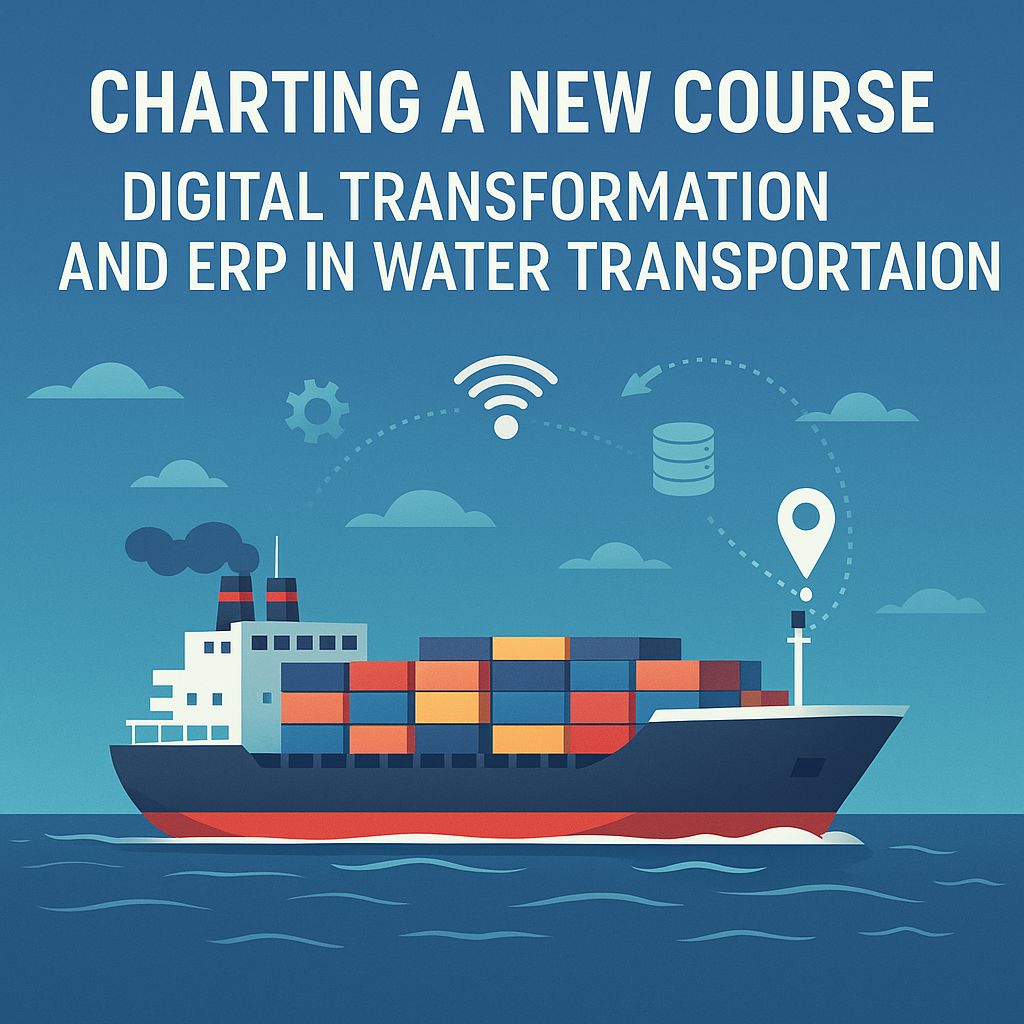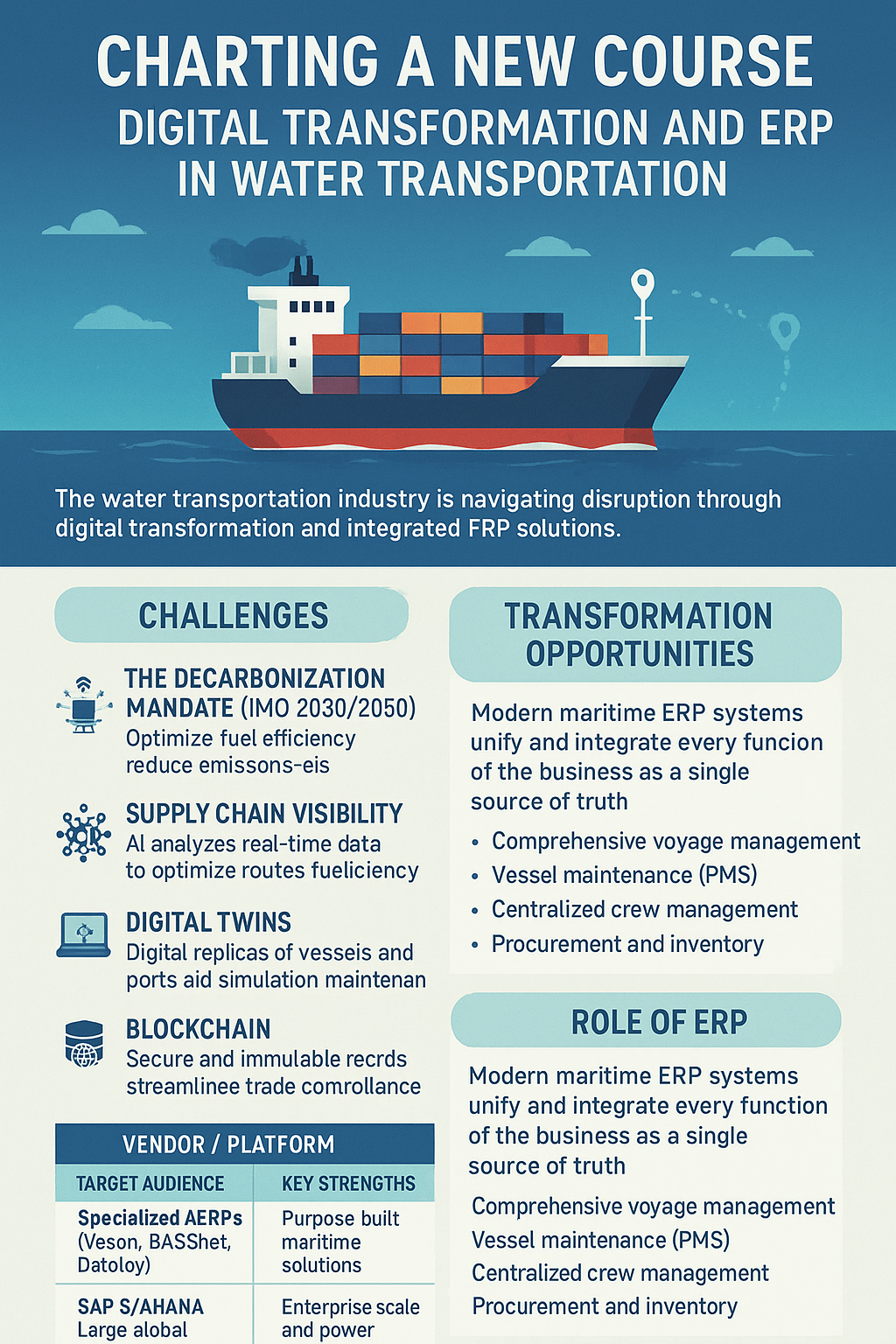Charting a New Course: How Digital Transformation and ERP are Navigating the Future of Water Transportation
2025-10-08 · By Anil Kancharla · 7 min read
❤️ 0 Likes · 👁️ 0 Views
 AI-generated image for illustration purposes only.
AI-generated image for illustration purposes only.
Charting a New Course: How Digital Transformation and ERP are Navigating the Future of Water Transportation
 AI-generated image for illustration purposes only.
AI-generated image for illustration purposes only.
Charting a New Course: How Digital Transformation and ERP are Navigating the Future of Water Transportation
October 8, 2025 – The water transportation industry is the invisible giant of the global economy. It’s the silent workhorse that moves approximately 90% of world trade, from the fuel in our cars and the food on our tables to the clothes we wear. This vast network of container ships, tankers, bulk carriers, and barges is the circulatory system of modern commerce. But as we navigate the mid-2020s, this colossal industry is charting a new course through the challenging waters of a new era.
Today’s shipping lines, port operators, and vessel managers are contending with an unprecedented wave of disruption. They face a powerful mandate for decarbonization, intense pressure for end-to-end supply chain visibility, the logistical complexities of port congestion, and the critical challenge of managing a global workforce at sea. The traditional, paper-based, and siloed operational models of the past are no longer seaworthy.
The journey forward is one of profound reinvention, powered by digital transformation. And the ship’s command center, the integrated platform that connects every vessel, every container, every crew member, and every process, is a modern, maritime-focused Enterprise Resource Planning (ERP) system.
This in-depth blog post will explore the complex world of the modern water transportation industry, uncover the immense opportunities of its digital evolution, and provide a comparative analysis of leading ERP solutions designed to help the sector navigate toward a more profitable and sustainable future.
Navigating Turbulent Waters: Challenges Facing the Maritime Industry in 2025
The maritime industry is facing structural shifts that are fundamentally reshaping its operational and strategic priorities.
- The Decarbonization Mandate (IMO 2030/2050): This is the single greatest challenge and driver of change. International Maritime Organization (IMO) regulations demand drastic cuts in greenhouse gas emissions. This requires a massive shift in vessel technology, the adoption of alternative fuels (like LNG, methanol, or ammonia), and, most immediately, the relentless optimization of every voyage to maximize fuel efficiency and minimize emissions. ESG (Environmental, Social, and Governance) performance is no longer optional; it's a license to operate.
- The Demand for Supply Chain Visibility: The era of the "black box" ocean transit is over. Shippers and cargo owners, conditioned by the transparency of e-commerce, now demand real-time visibility into their shipments. They want to know where their container is, when it will arrive, and if there are any delays, creating immense pressure for carriers to provide accurate, live data.
- Operational Efficiency and Port Congestion: Fuel is a massive cost, and vessel time is money. Inefficiencies like suboptimal routing, unplanned maintenance, and extended waiting times at congested ports can destroy the profitability of a voyage. Maximizing asset utilization and ensuring smooth port calls are critical operational imperatives.
- Crew Management and Welfare: Managing a diverse, global, and often unionized workforce of seafarers is incredibly complex. This includes handling multi-currency payroll, ensuring certifications are up-to-date, managing crew changes in ports around the world, and, increasingly, focusing on crew welfare and connectivity to attract and retain talent in a competitive market.
- Stringent Safety and Compliance: The maritime world is governed by a complex web of international safety (SOLAS), environmental (MARPOL), and labor (MLC) regulations. Maintaining compliance and a strong safety culture (EHSQ - Environment, Health, Safety, and Quality) is paramount to protecting the crew, the cargo, the vessel, and the environment.
The Digital Wake: Key Transformation Opportunities
Digital transformation, often dubbed "Maritime 4.0," provides a powerful set of technologies to address these challenges, unlocking new levels of efficiency, safety, and sustainability.
-
The Connected Vessel and Performance Optimization Modern vessels are becoming floating IoT platforms. Thousands of sensors on the engine, hull, and navigation systems stream a constant torrent of data. This enables:
- Vessel Performance Monitoring: Real-time analysis of fuel consumption, engine performance, and hull fouling to make immediate adjustments and optimize efficiency.
- Predictive Maintenance: AI algorithms analyze sensor data to predict when a critical piece of machinery is likely to fail, allowing for proactive maintenance to be scheduled at the next port call, preventing costly breakdowns at sea.
-
AI-Powered Voyage and Route Optimization This goes far beyond standard weather routing. AI platforms can analyze thousands of variables in real-time—including weather, ocean currents, port traffic, fuel price, and the vessel's specific performance characteristics—to recommend the single most optimal route and speed to minimize fuel consumption while meeting the voyage schedule.
-
Digital Twins for Vessels and Ports A digital twin is a living, virtual replica of a physical asset. A vessel's digital twin can be used to simulate performance under different conditions and optimize maintenance strategies. A port's digital twin can be used to simulate vessel traffic and cargo movements to optimize berth allocation and reduce congestion.
-
Blockchain for Secure and Transparent Trade The traditional Bill of Lading is a paper-based, centuries-old process. Blockchain offers a secure, digital, and immutable alternative, creating a single source of truth for all stakeholders in a shipment (shipper, carrier, consignee, bank) that can streamline trade finance and reduce fraud.
The Integrated Bridge: ERP as the Single Source of Truth
With a fleet of vessels spread across the globe, each generating vast amounts of operational data, how does a shipping company manage it all? How can they connect the crew on the ship to the chartering desk and the finance department ashore? This is the mission-critical role of a maritime Enterprise Resource Planning (ERP) system.
The ERP is the shore-based command center, integrating every function of the business—from vessel operations and crewing to procurement and finance—into a single, unified platform.
Core Benefits of a Maritime ERP:
- Comprehensive Voyage Management: The ERP manages the entire lifecycle of a voyage, from chartering and scheduling to execution and financial settlement. It tracks voyage costs, calculates profitability in real-time, and ensures compliance with charter party agreements.
- Vessel Maintenance and Planned Maintenance Systems (PMS): A core module that manages all planned and unplanned maintenance for the fleet. It schedules inspections, tracks the status of work orders, and maintains a complete history of every piece of equipment for class surveys and regulatory audits.
- Centralized Crew Management: Manages the entire crew lifecycle, including maintaining personnel records, tracking certifications and training, planning crew changes, and handling complex multi-currency payroll.
- Global Procurement and Spare Parts Inventory: Streamlines the procurement of spares, supplies, and bunkers (fuel). It provides visibility into the inventory held on each vessel and coordinates delivery to ports around the world to ensure vessels are always properly supplied.
- EHSQ and Compliance Management: Serves as the system of record for safety and environmental compliance. It helps manage safety audits (ISM Code), track environmental performance for IMO reporting, and maintain all necessary documentation for port state control inspections.
Choosing Your Navigation System: A Look at Leading ERPs for the Maritime Industry in 2025
The ERP market for this highly specialized industry includes global enterprise players and deep, purpose-built maritime software providers.

Charting a Course for the Future
The water transportation industry is at the helm of its own transformation. The future of shipping will be defined by data, driven by efficiency, and measured by sustainability. The companies that will lead this new era will be those that break down information silos and harness the power of digital technology to create an intelligent, transparent, and resilient operation.
This transformation is impossible with a patchwork of disconnected, legacy systems. It requires a powerful, integrated digital core. By investing in a modern, maritime-focused ERP system, shipping companies can gain a 360-degree view of their fleet, empower their crews, and make the data-driven decisions necessary to navigate the complexities of 2025 and chart a course toward a more profitable and sustainable horizon.
💌 Enjoyed this article?
If you found this post valuable, subscribe to my newsletter for more insights on digital transformation, AI, and business innovation.
👉 Subscribe to the newsletterOr let’s connect on LinkedIn — I share weekly content that’s practical for CIOs, CFOs, and transformation leaders.
🔗 Connect with me on LinkedIn